 The 7mm-08 Remington is the Rodney Dangerfield of cartridges; modest in appearance, potentially exceptional in performance. Without hyper velocity and eyebrow raising knock down power, the 7mm-08 Remington is easy to overlook on a cartridge comparison chart, but twenty-eight years in production suggests that more than a few shooters have discovered its worth. The 7mm-08 cartridge is at the foundation of any number of fast handling, light recoiling, compact firearms that are appropriate for all North American game, perhaps with the exception of big bear. I only note the latter because I don’t know and it wouldn’t be a great place for casual speculation at someone else’s expense.
The 7mm-08 Remington is the Rodney Dangerfield of cartridges; modest in appearance, potentially exceptional in performance. Without hyper velocity and eyebrow raising knock down power, the 7mm-08 Remington is easy to overlook on a cartridge comparison chart, but twenty-eight years in production suggests that more than a few shooters have discovered its worth. The 7mm-08 cartridge is at the foundation of any number of fast handling, light recoiling, compact firearms that are appropriate for all North American game, perhaps with the exception of big bear. I only note the latter because I don’t know and it wouldn’t be a great place for casual speculation at someone else’s expense.
Obligatory offer of well worn insight…
In 1980, the 7mm-08 Remington, was annexed by Remington from the world of wildcats. The 1958 precursor to the 7mm-08 Remington was the 7mm/308, a round made by simply necking down a .308 Winchester to 7mm. The move on Remington’s part to commercialize the cartridge was fortunate for all of us, as Remington obtaining SAAMI homogulation ensured uniform rifle and ammunition specifications. Additionally, as a legitimized commercial cartridge, factory ammo made it to retailers’ shelves, thereby expanding and perpetuating the popularity of the cartridge. Today, both rifles and ammunition are readily available from numerous manufacturers. For us handloaders, it is an excellent cartridge from the standpoints of performance potential, low cost production and the availability of a wide range of components.
It’s the bullets, man…
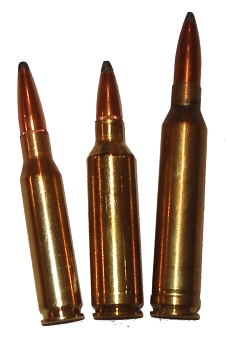 A significant 7mm advantage is the caliber’s comparatively high sectional density. A high SD means bullets will hold onto velocity longer, shoot flatter and arrive on target with greater residual kinetic energy than comparable bullets of a lower SD. Beyond 200 yards, it is common for the 7mm-08 Remington to overtake and outperform larger bore cartridges that initially generated higher muzzle velocity and energy.
A significant 7mm advantage is the caliber’s comparatively high sectional density. A high SD means bullets will hold onto velocity longer, shoot flatter and arrive on target with greater residual kinetic energy than comparable bullets of a lower SD. Beyond 200 yards, it is common for the 7mm-08 Remington to overtake and outperform larger bore cartridges that initially generated higher muzzle velocity and energy.
A second 7mm advantage comes from the commercial success of a diverse group of 7mm cartridges. From the 7mm Bench Rest through to the 7mm Ultra Mag, there are at least ten significant 7mm rounds that have persisted in production. The velocity spread for these rounds, using a 140 grain bullet as a common denominator, runs from 2,000 fps to 3,500 fps. This range in performance has led to bullets of a common weight being developed with varying degrees of toughness and construction. While it takes patience to determine what exactly is right for any given application, 7mm handloaders have the distinct advantage of being able to select from a long list of bullets. 7mm bullets are also on the good side of the price break between low cost and costly calibers.
The 7mm-08 Remington handloading project
Usually, I have to scrounge around for bullet sources to cover my bases on projects; not so with the 7mm-08. All bullets appearing on the table below are suitable for everything from deer to elk and moose when loaded at 7mm-08 Remington velocity levels. Pushed to 7mm STW or 7mm Ultra Mag near range velocity, the 120 grain Sierra and 139 grain Hornady might be a slightly light for the largest of these animals, but not light enough to remove them from the list.
| Project Bullet Selection | |||||||
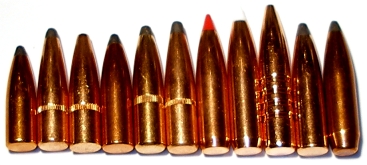 |
|||||||
| Manufacturer Left – Right |
Bullet Type | Weight Grains |
Bullet Length” | MV / Impact Min Velocity |
Max Rifle COL” | Cartridge COL” | COL Determinant |
| Sierra | ProHunter | 120 | 0.973 | 2,600 MV | 2.762 | 2.742 | Rifling clearance |
| Hornady | Interlock | 139 | 1.136 | 2,000 MV | 2.850 | 2.830 | Mag well clearance |
| Remington | PSP | 140 | 1.095 | 1,390 Impact | 2.800 | 2.780 | Rifling clearance |
| Speer | Spitzer | 145 | 1.106 | N/A | 2.753 | 2.733 | Rifling Clearance |
| Winchester | Power Point | 150 | 1.190 | 1,600 Impact | 2.842 | 2.830 | Mag well clearance |
| Hornady | Interlock | 154 | 1.230 | 2,300 MV | 2.870 | 2.830 | Mag well clearance |
| Nosler | Ballistic Tip | 150 | 1.131 | 1,600 Impact | 2.859 | 2.830 | Mag well clearance |
| Nosler | AccuBond | 160 | 1.403 | 1,800 Impact | 2.868 | 2.830 | Mag well clearance |
| Barnes | Triple Shock | 160 | 1.400 | 1,800 Impact | 2.837 | 2.830 | Mag well clearance |
| Speer | Spitzer | 160 | 1.239 | N/A | 2.896 | 2.830 | Mag well clearance |
| Sierra | Spitzer | 160 | 1.261 | 2,500 MV | 2.778 | 2.778 | Rifling clearance |
Being as one with your COL…
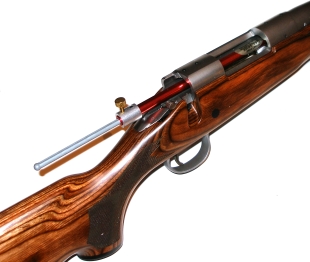 This handloading effort began with the assumption cartridge length would have to be maximized, highly compressed charges would be the norm and generally performance of bullets above 140 grains would be disappointing. All which proved to be a great illustration of the old adage, “When you assume, you make an “ass” of “u” and “me”, although I am not so sure about the “me” part. There are many smokeless powder selection that fill up a case, but don’t come close to being a compressed charge with any bullet through 160 grains. Playing with COL to maximize case capacity by seating bullets out is generally a waste of time and won’t result in a grain’s worth of additional capacity; AKA a colossal waste of time.
This handloading effort began with the assumption cartridge length would have to be maximized, highly compressed charges would be the norm and generally performance of bullets above 140 grains would be disappointing. All which proved to be a great illustration of the old adage, “When you assume, you make an “ass” of “u” and “me”, although I am not so sure about the “me” part. There are many smokeless powder selection that fill up a case, but don’t come close to being a compressed charge with any bullet through 160 grains. Playing with COL to maximize case capacity by seating bullets out is generally a waste of time and won’t result in a grain’s worth of additional capacity; AKA a colossal waste of time.
Setting aside the issue of maximum effort and little return in the quest for recovering case capacity, there are other things to bump into when trying to increase COL above norms; bullet / land contact and magazine well interference will cut creative bullet seating short…literally. The Remington Mountain Rifle LS, with the right bullet, would chamber and cycle a cartridge assembled to 2.920″. Unfortunately, the rifle’s magazine well wouldn’t reliably clear rounds longer than 2.830″ and some blunt ogive bullets forced a COL limitation of 2.742″. A check of commercial 140 grain ammo indicated a maximum cartridge length of 2.760″, which makes a lot of sense as the SAAMI standard for COL is 2.800″. There was an additional 0.030″ to eke out of this specific combination which yielded…well, basically nothing, but it was my 0.030″ to burn.
The COL listings within this text are bullet tip to case head dimensions, however, handload measurements in the shop are measured with a bullet comparator to avoid inaccuracies caused my deformed or short lead bullet tips. A headspace gauge is used to set up a sizer die after the first use of brass to maximize capacity and minimize brass working. All of the tools and tasks referenced here are covered in detail at “Gauging Success – Minimum Headspace, Maximum COL“.
And then the rains came…
Think of this little interlude as intermission at the movies, for those of you who have been around long enough to have gone to the movies where two shows played for less than a buck and there were at least two characters who didn’t: have purple hair and aspire to play in a rock band, participate in shoot outs with guns tipped on their sides or take off their clothes for no apparent reason other than to flash the artistry of some half baked and less than artful plastic sturgeon (Yes, I know I wrote “sturgeon”). It has been thundering and lightening on and off for three days. Power went out and the generator took an indirect hit that pumped 300 volts to the main box. We are holding services for a Maytag Dryer this afternoon and I am too choked up to write in much detail. Have you seen the current price tag for one of those suckers? Besides, every time I thought about raising the chronograph on a tripod out back, I had flashes of images of Dr. Frankenstein raising the monster to the roof of the laboratory and we all know what happened then. Anyway…
Tools and equipment, as I wander off course a bit…
 The 7mm-08 Remington is a shoe in for basic turret press handloading. The press, pictured, is a $100 auto-progressive Lee Classic Turret. The indexing rod, the twisty deal running from turret straight down behind the shell holder, is removed for short run load development and installed for longer production runs. I received a few inquiries recently where potential press users reported being told the turret in the Lee Classic is difficult to remove. There is no way this comment could have originated with anyone who has actually used the press. You twist and lift up and the turret pops out. The indexing rod is then either removed or dropped into the lower indexing rod clamp and the turret is then popped back into place.
The 7mm-08 Remington is a shoe in for basic turret press handloading. The press, pictured, is a $100 auto-progressive Lee Classic Turret. The indexing rod, the twisty deal running from turret straight down behind the shell holder, is removed for short run load development and installed for longer production runs. I received a few inquiries recently where potential press users reported being told the turret in the Lee Classic is difficult to remove. There is no way this comment could have originated with anyone who has actually used the press. You twist and lift up and the turret pops out. The indexing rod is then either removed or dropped into the lower indexing rod clamp and the turret is then popped back into place.
I picked up a Lee Precision three die set; sizer, seater and factory crimp die. The set includes a shell holder, which is perfect for a lazy guy like me who doesn’t like to sift through a bin full of shell holders. At $25, the dies are inexpensive and the crimp die is a lot cleaner than playing with bullet seating depth – roll crimp adjustments. The Lee Safety prime press mounted system is a good one, however, change comes hard to…mature handloaders and I have tens of thousands of strip mounted primers to work my way through before I stop using my RCBS bench mounted APS press.
 If you’ve ever worked around a machine shop or manufacturing environment, you probably enjoy playing with Lee Precision tools and trying to guess the intent of the designs as there is always some ingenious little twist in there somewhere. The Lee Precision Case Trimmer is a good example of a considered design.
If you’ve ever worked around a machine shop or manufacturing environment, you probably enjoy playing with Lee Precision tools and trying to guess the intent of the designs as there is always some ingenious little twist in there somewhere. The Lee Precision Case Trimmer is a good example of a considered design.
The trimmer is comprised of four components; lock stud, shell holder, case length gauge and cutter. The lock stud and cutter are universal so only one set must be purchased for all cartridges, at least through .475″ bullet size. A larger version covers above this size. The former is a $5 set, the latter a $10 set. Different length gauges and shell holders are required for different cartridges, but the cost is typically $3 and change for a set. The big deal, however, isn’t price, it is function.
A cartridge case is slipped into the shell holder, then the lock stud is screwed into the shell holder until it clamps the case in place and holds it stationary. A length gauge is screwed into the cutter until it bottoms on a positive stop shoulder, no subjective adjustment is necessary. That assembly is fed through the mouth of the cartridge until the pin at the end of the length gauge passes through the case’s flash hole and stops with either the shoulder above the small diameter pin sitting on the interior case web or the cutter’s blades coming in contact with the case mouth. You hold the lock stud/shell holder assembly in one hand, then press in on the cutter with the other hand and turn clockwise until the cutter stops removing brass. If no brass is removed at all, that means the case does not need trimming. Because the alignment of the cutter to case is established by the longitudinal alignment of the flash hole and case mouth, the mouth is cut square to the case head. In a number of lathe cutter designs the case mouth is located on a pilot at the cutting head, then clamped, but not positively located at the rear of the case, so there is little to assure a square cut.
And with the sun comes – Bang Bang…Bang, Etc.
All of the loads indicated on the table utilize CCI 200 primers. There are two compressed loads as indicated by a “C” next to the associated charge. BL-C2 is probably the best all around powder, although IMR 4895 isn’t bad either. I would have liked to have tried Re 17 but, unfortunately, I couldn’t put that one together this time around.
Predictive software like QuickLoad demonstrated mixed results. Velocity, depending on powder type, varied by as much as 10% to actual results, which means pressures are not nailed down within 10%. There were no flattened primers or stretched case heads or sticky extractions with any of these loads, but some are definitely on the warm side. You know the drill, back off 5% and work up as results, observation and common sense dictate.
| Bullet Type | Bullet Weight | Net Water Capacity | COL | Powder Type | Powder Charge | Actual Muzzle Velocity |
| Sierra Prohunter | 120 | 51.9 | 2.742 | W 748 | 47.0 | 3103 |
| Re 15 | 48.0 | 3045 | ||||
| BL-C2 | 49.0 | 3245 | ||||
| Hornady Interlock | 139 | 49.2 | 2.830 | Varget | 44.0 | 2849 |
| IMR 3031 | 41.0 | 2840 | ||||
| IMR 4895 | 43.5 | 2870 | ||||
| Barnes TSX BT** | 140 | 47.7 | 2.830 | Re 15 | 43.5 | 2843 |
| BL-C2 | 45.0 | 2922 | ||||
| IMR 4895 | 42.5 | 2915 | ||||
| Remington Core-Lokt | 140 | 49.6 | 2.780 | Re 15 | 45.0 | 2855 |
| BL-C2 | 46.0 | 2938 | ||||
| IMR 4895 | 44.0 | 2920 | ||||
| Speer Spitzer | 145 | 48.5 | 2.733 | Re 15 | 43.5 | 2782 |
| BL-C2 | 45.0 | 2892 | ||||
| IMR 4350 | 48.0 | 2741 | ||||
| Winchester PP | 150 | 48.6 | 2.830 | Re 19 | 50.0C | 2793 |
| IMR 4895 | 42.5 | 2828 | ||||
| IMR 4350 | 47.0 | 2721 | ||||
| Nosler Ballistic Tip | 150 | 47.1 | 2.830 | Re 15 | 42.5 | 2730 |
| BL-C2 | 43.5 | 2812 | ||||
| IMR 4895 | 41.5 | 2735 | ||||
| Hornady Interlock | 154 | 48.5 | 2.830 | Re 19 | 49.5C | 2759 |
| IMR 4895 | 42.0 | 2765 | ||||
| IMR 4350 | 46.5 | 2645 | ||||
| Nosler AccuBond | 160 | 45.3 | 2.830 | Varget | 40.0 | 2617 |
| IMR 4895 | 40.0 | 2722 | ||||
| IMR 4350 | 44.0 | 2610 | ||||
| Barnes | 160 | 45.2 | 2.830 | Varget | 40.0 | 2627 |
| BL-C2 | 41.5 | 2708 | ||||
| IMR 4895 | 39.5 | 2691 | ||||
| Speer Spitzer | 160 | 47.9 | 2.830 | Re 15 | 42.0 | 2642 |
| Re 19 | 48.5 | 2703 | ||||
| BL-C2 | 43.5 | 2691 | ||||
| Sierra | 160 | 47.2 | 2.778 | Re 15 | 41.5 | 2600 |
| IMR 4895 | 41.0 | 2650 | ||||
| IMR 4350 | 45.0 | 2669 | ||||
|
** Bullet last minute project addition. C=compressed loads. CCI 200 primers used for all loads. |
||||||
Bullet Flatitudinous…es
Practical hunting ranges, at least in my part of the world, are covered with this round. The 140 grain Remington Core Lokt and Barnes Triple Shock, working with a 3″ critical target size, table below, are almost identical in trajectory; point blank out to 221 yards, not varying more than 1.5″ above or below line of sight. Even at 300 yards total drop is only 8″. Kinetic Energy at 200 yards is just under a ton. At 300 yards either bullet still delivers approximately 1,600 ft-lbs of energy.
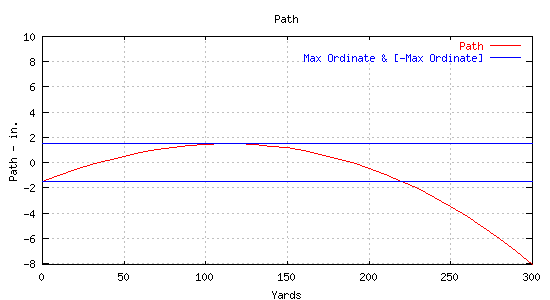
Above 140 grains, bullet selection based on ballistic coefficient becomes more critical or weight advantage is lost to increased drop and reduced retained energy. The table below represents the 150 grain Winchester and 154 grain Hornady loads. The Winchester delivers about 300 ft-lbs less energy than the 140 grain loads. The 154 grain Hornady, because of its superior ballistic coefficient, delivers about the same energy levels as the hot 140 grain loads and shoots about as flat as the Winchester 150 grain. So it becomes a personal and more subjective decision regarding the value of the extra 14 grains of bullet weight over the 140 grain loads.

The Speer 160 grain bullet holds onto energy at longer ranges. It slightly outperforms the hot 140 grain loads out through 200 yards, then pulls ahead by a couple hundred ft-lbs of KE out at 300 yards. Point blank range is reduced by only 10 feet or so in comparison to the 140 grain bullets, approximately 212 yards, and drop at 300 yards increases by approximately 1.8″ for a total of 9.8″ at a hundred yards with optimal zeroing ranges.
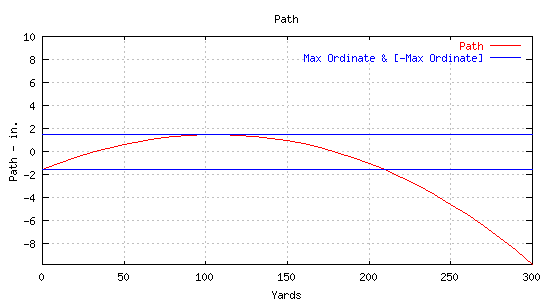
The best performing heavy weight was the Barnes 160 grain Triple Shock. It outputs the highest levels of energy, has the longest point blank range at 232 yards and drops slightly more than 8″ at 300 yards, keeping right up with the 140 grain bullets in flat shooting.
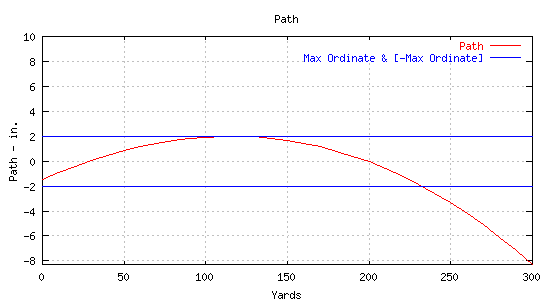
Impressions?
The combination of the Remington Mountain Rifle and 7mm-08 Remington is a tough one to put down. Recoil is negligible, but the gun’s got a healthy bark. Accuracy was very good, as posted in the Real Guns handload section on the home page. I like the cartridge a lot. It offers bullets that are well out of reach of the .243 Winchester and it shoots a lot flatter than the .308 Winchester. I kept thinking it would be the perfect gun for black bear and deer season here in Maine. The rifle is light and compact and the 22″ barrel is a perfect length for this round. I’d like to see an open sight option for those of us who have to hunt in dense brush with few clearings.
Any concerns I had about lightweight 7mm bullets being fragile were dispelled. Even the lightest bullets could pop through two green 4″x4″ posts without falling apart, but leaving a large “exit wound”. I’d have cooked them but I couldn’t find a recipe. Not only is there a wide range of bullets, there is a wide range of useful bullets. Now if I can find a pig hunt in Texas, I won’t have to wait for the fall.
Related 7mm-08 Remington information on RealGuns.Com:
Remington’s Model 700 Mountain Rifle LSS
Handloading the 7mm-08 Remington – Hey, it’s not that slow!
7mm-08 Remington Handload Data

Email Notification